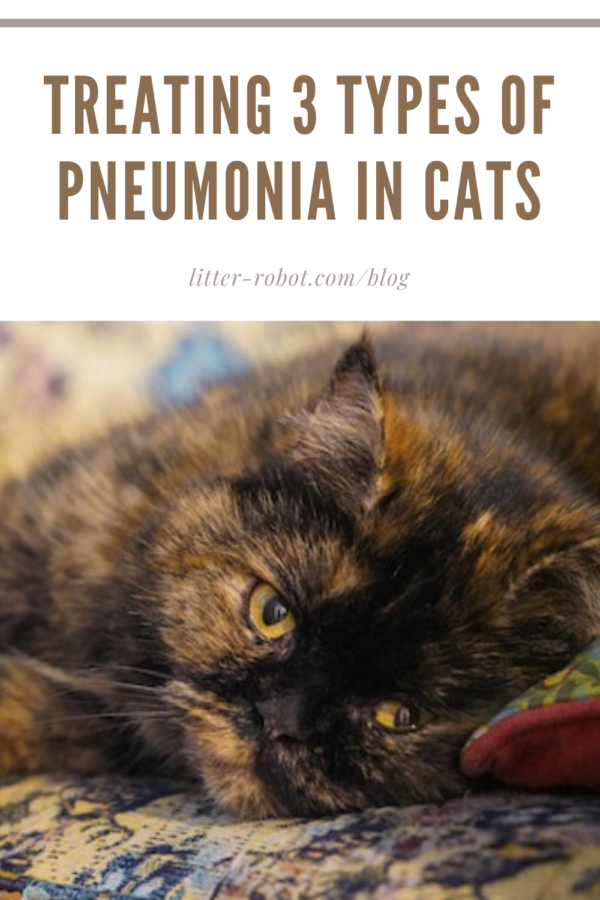what can i do to help my cat with pneumonia
Pneumonia, the inflammation of the lungs, is relatively uncommon in cats. Regardless, it's important to be aware of the symptoms of feline pneumonia, as information technology tin can be life-threatening if left untreated. Notice out how to treat three types of pneumonia in cats, including aspiration pneumonia, bacterial pneumonia, and fungal pneumonia.
Reminder: What are upper respiratory infections in cats?
Upper respiratory infections (URIs) are far more mutual in cats than pneumonia. As Dr. Justine Lee explains, URIs are the equivalent of a "common cold" in humans, although the underlying causes are unlike. URIs are a common cause of sneezing, fever, runny eyes, and conjunctivitis in cats.
Unfortunately, feline upper respiratory infections are extremely infectious and contagious—and if left untreated, they can pb to pneumonia in cats.
Signs of pneumonia in cats
Like humans, pneumonia in cats is more probable to occur (and more than difficult to care for) in the very immature, the very old, and cats with compromised immune systems. Although symptoms can vary slightly depending on the type of pneumonia, yous should generally exist on the lookout for signs that include:
- Difficulty breathing or swallowing
- Cough
- Increased respiratory rate
- Rapid heartbeat
- Light-green or yellow nasal discharge
- Fever
- Dehydration
- Loss of appetite
- Weight loss
- Lethargy
Aspiration pneumonia in cats
Aspiration pneumonia occurs when a cat has inhaled (aspirated) substances into the lungs, including vomit, food, or foreign matter such every bit a tiny piece of plastic. For instance, "a cat may vomit and, in the process, inhale some of its breadbasket contents, which tend to exist very acidic and will likewise irritate the tissues," explains Dr. Daniel Fletcher of Cornell Academy'southward College of Veterinary Medicine.
Other surprising triggers of aspiration pneumonia in cats include general anesthesia, faulty administration of liquid medication, inhalation of fume or other harsh chemicals, seizure disorders, and chronic airsickness.
Treating aspiration pneumonia
Aspiration pneumonia in cats commonly requires extensive treatment that may include abdominal palpation, chest X-rays, a complete blood count, a complete chemistry profile, removing fluid from the lungs or airway suctioning, oxygen therapy, and an 4 drip. Cats with this type of pneumonia volition need to rest in a stress-gratis surround under careful supervision, potentially for several weeks.
Fifty-fifty with treatment, cats with aspiration pneumonia may take a poor prognosis. That's why it'southward imperative to get your cat to the vet if yous detect any of the symptoms above.
Bacterial pneumonia in cats
Bacterial pneumonia in cats tin occur subsequently exposure to bacterial agents inhaled from the environment or from other cats. Information technology can also ascend from an existing bacterial infection elsewhere in the body. Co-ordinate to PetMD, the bacterial organisms Bordetella bronchiseptica, Pasteurella, and Moraxella are most frequently reported in cases of bacterial pneumonia.
Treating bacterial pneumonia
With proper treatment, the prognosis for bacterial pneumonia in cats is generally good. The vet may perform a tracheal launder to gather cloth for assay, along with other tests such as chest X-rays, a complete blood count, and urinalysis. Antimicrobial treatment will be adamant once the specific leaner has been identified. Depending on the cat's status, oxygen therapy and an Four drip may need to be administered equally well.
Fungal pneumonia in cats
Fungal pneumonia in cats results from an infection after exposure to fungi inhaled from the environs or from other cats. Some types of fungi or mold that can cause lung fungal infections include Blastomyces, Histoplasma, and Aspergillus. Co-ordinate to Dr. Karen Shaw Becker, "exposure can happen through contact with soil that'southward rich in organic matter, bird droppings, or feces."
Treating fungal pneumonia
A fungal infection in cats may first present equally an eye or pare problem. A veterinarian will need to analyze fluid collected on the true cat'due south transtracheal wash. Other tests may include a urinalysis, chest X-rays, a fungal PCR assay, and an abdominal ultrasound.
The precise handling depends on the blazon of fungus that has caused the infection. Unfortunately, many cats are unresponsive to fungal pneumonia medication.
How to prevent pneumonia in cats
The adept news is, pneumonia in cats is relatively rare. Proceed your cat up to date on vaccines, and keep your cat indoors if possible. Do your function to limit your kitty'southward exposure to fume, chemicals, and other problematic inhalations. Furthermore, if you suspect your cat has even an upper respiratory infection or yous find your true cat exhibiting whatsoever of the symptoms higher up, become to a veterinary right away to forestall the illness from worsening.
Sources:
- Cornell Feline Health Center
- PetMD
- Dr. Karen Becker Shaw
Cover photograph by Zosia Korcz on Unsplash

Recommendations




Source: https://www.litter-robot.com/blog/treating-3-types-of-pneumonia-in-cats/
0 Response to "what can i do to help my cat with pneumonia"
Post a Comment